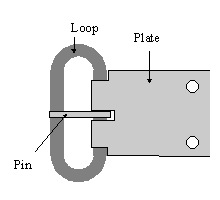
The simplest Anglo-Saxon buckles consisted of a loop (bow), a pin (tongue) and a belt plate as shown in fig.1. They were made of iron and/or bronze. Brass is a reasonable substitute for bronze.
|
|
| Figure 1: Parts of the buckle |
The loop can be cut from brass or iron plate (~2mm), or brass oval rings can sometimes be bought from leather shops. The pin can be bent from brass rod (1/8" or 3/32") or thin nails. The belt plate must be cut from thin sheet metal (see fig.2). Cut to size and bend over a nail. Drill a hole through the folded plate and cut in to the hole to make a notch for the pin. File the notch smooth.
|
|
| Figure 2: Conctruction of the buckle plate |
Assemble the buckle by bending the plate around the loop (fig. 2). Cut a notch in the end of the belt leather to allow the pin to run freely. Rivet the buckle to the belt as follows. Hold the buckle in place with the end of the belt sandwiched between the two halves of the plate. Drill holes through this sandwich and push a brass rod or nail through the hole. It is important that the rod is the same diameter as the hole. Cut the rod to size so that about 0.5mm protudes on each side. Place the buckle on a thick piece of steel (such as an anvil) and hammer the ends of the rod so that they splay out and hold the buckle fast. Turn the buckle over every few blows to make both sides even. A ball ended hammer is best for this, if available. Repeat for the other rivets.